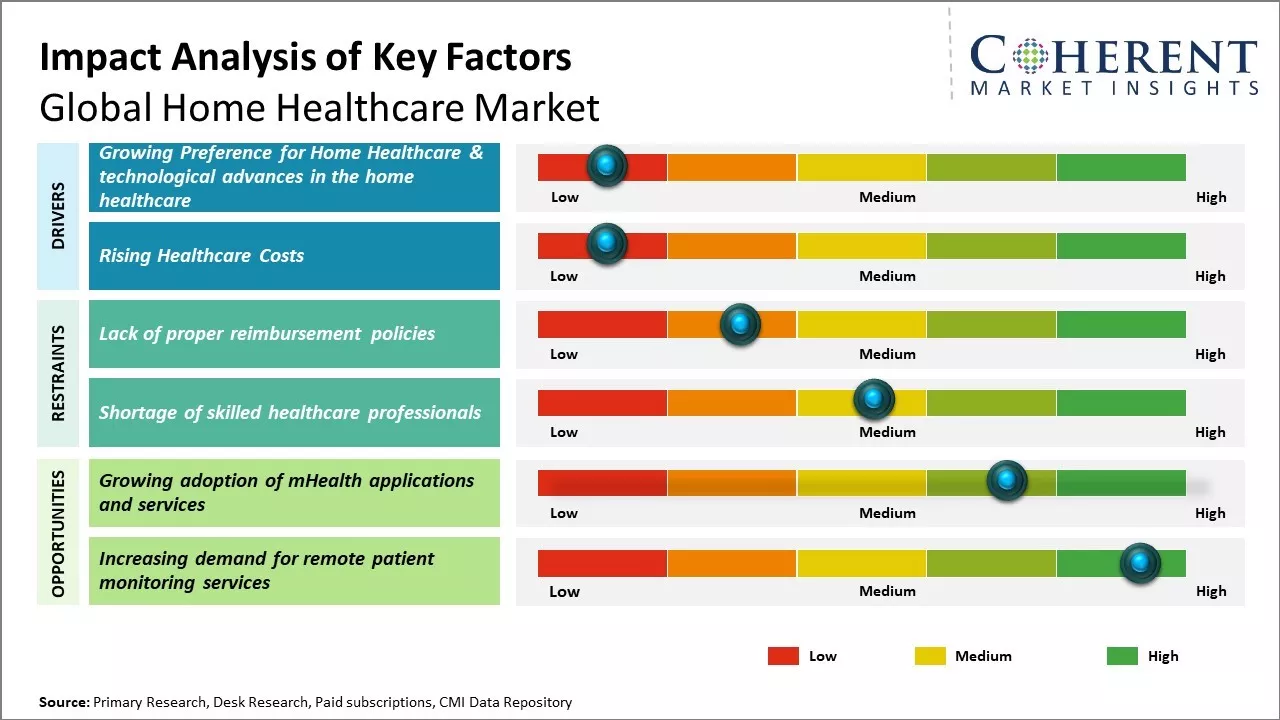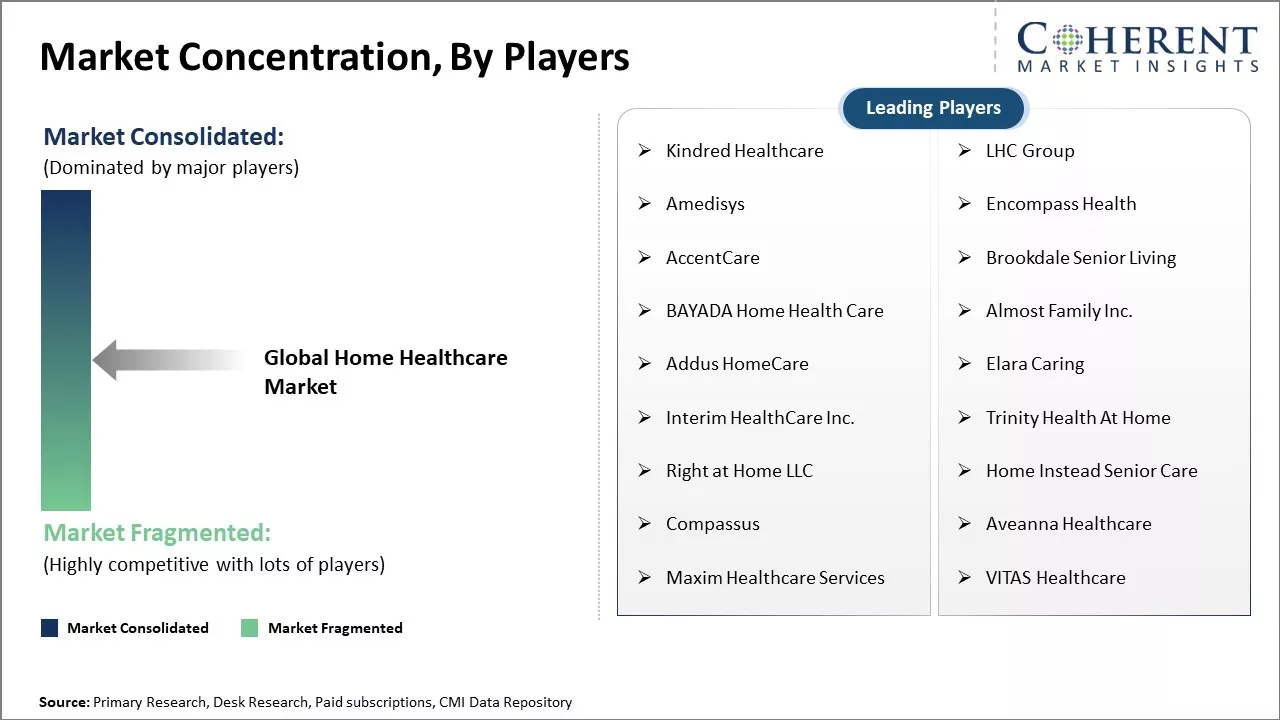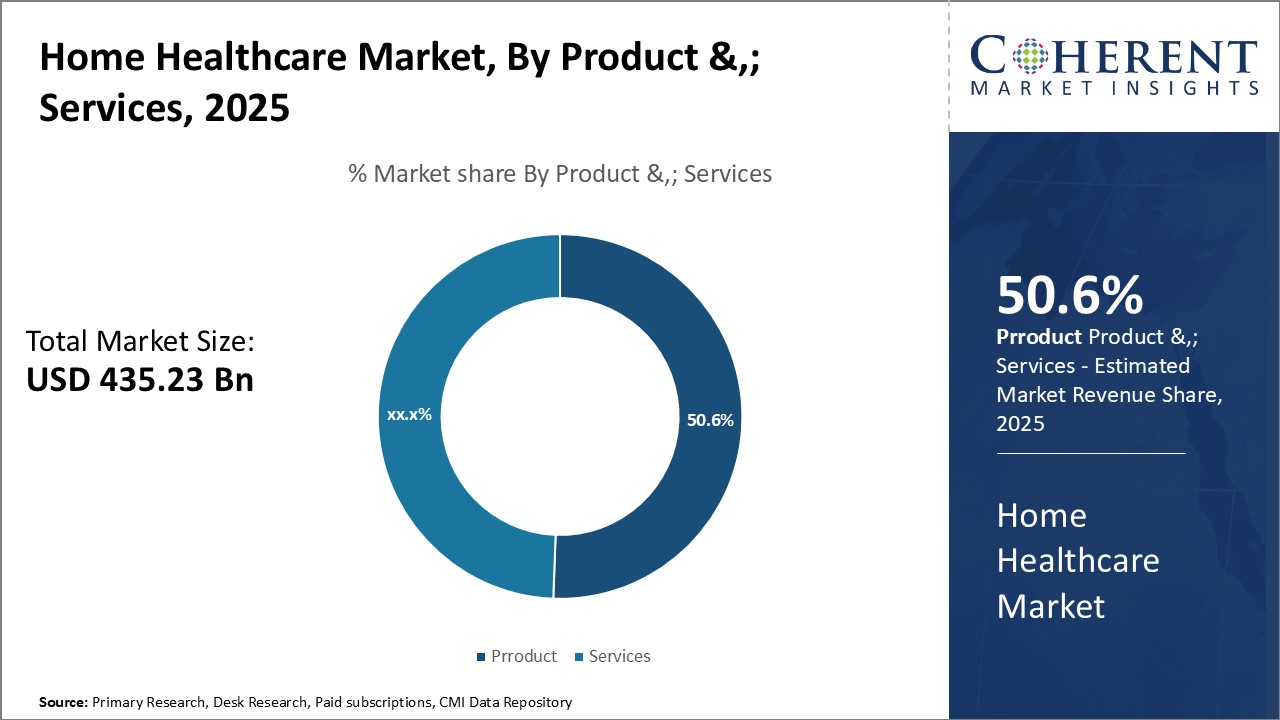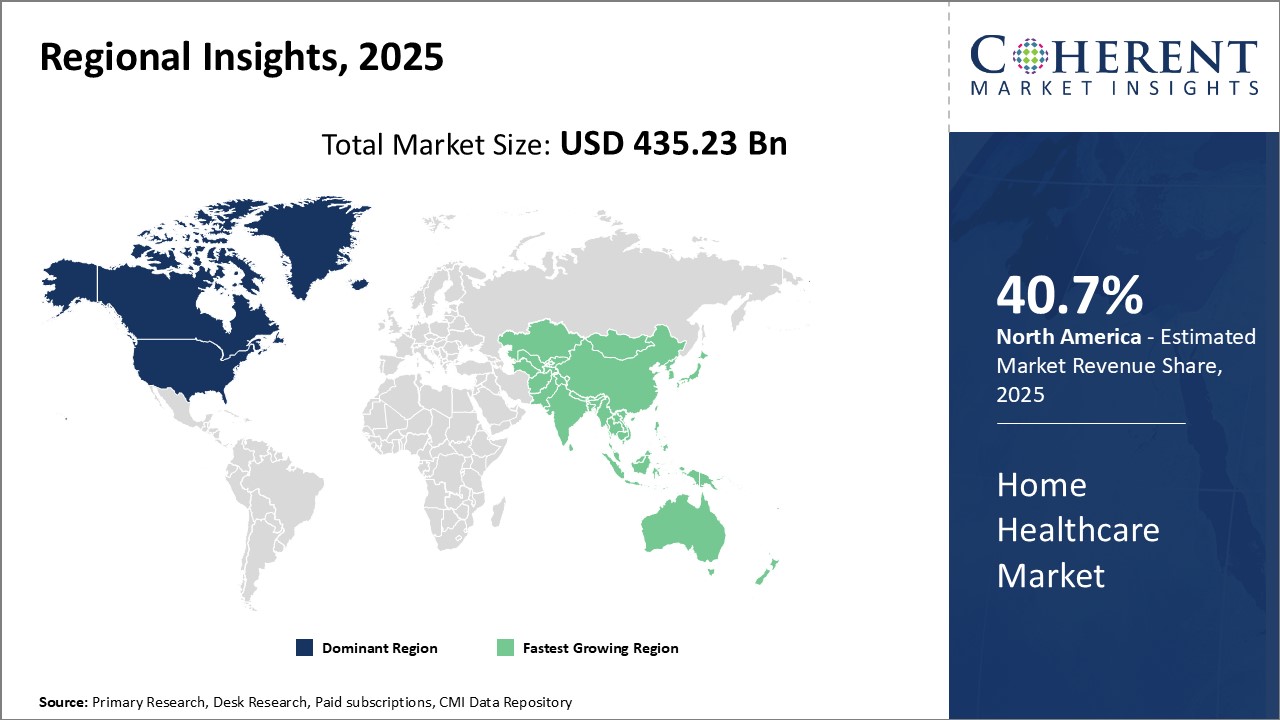Global home healthcare market is estimated to be valued at USD 435.23 Bn in 2025 and is expected to reach USD 770.92 Bn by 2032, exhibiting a compound annual growth rate (CAGR) of 8.5% from 2025 to 2032.

Discover market dynamics shaping the industry: Request sample copy
The market is expected to witness positive growth over the forecast period due to increasing preference for home healthcare services owing to benefits such as comfort of home environment, lesser costs involved, and growing geriatric population globally. Moreover, technological advancements pertaining to home care devices and rising incidence of chronic illnesses have boosted diagnostic and point-of-care testing at home. However, data privacy and security concerns can hamper the market growth.
Growing preference for home healthcare & technological advancements in the home healthcare
Global home healthcare market is witnessing significant growth due to growing preference for home healthcare services among patients and their families. Receiving medical care at home allows patients to recover in the comfort of their home surroundings alongside family support. It avoids the hassles and risks of hospital visits while being more cost-effective. As patients seek alternatives to long hospital stays, home healthcare has emerged as a convenient and affordable option. Technological advancements also boosts adoption of home healthcare services. Various digital health solutions have enabled remote patient monitoring, disease management and administration of complex treatments at home. This has improved health outcomes and quality of life for chronic disease patients. For example, devices connected to the internet allow caregivers to keep track of vital signs like blood pressure, glucose levels, and others from remote locations and ensure timely diagnosis of health deteriorations. Video consultations have also reduced the need for in-person visits. Wearable biosensors embedded with artificial intelligence are aiding non-invasive home care by catching early signs of diseases. For instance, in March 2022, Biofourmis was chosen by Blessing Health System in Quincy, U.S. to collaborate as technology solutions partner for its latest initiative, thus, providing acute hospital care directly to patients at home. In December 2022, Tomorrow Health, a health tech firm, introduced a clinical rules engine that is designed to automate the ordering process for durable medical equipment as part of home healthcare services.

Get actionable strategies to beat competition: Request sample copy
Rising Healthcare Costs
Rising healthcare costs can boost demand for home-based medical services. Treatment and long-term care in hospitals or nursing homes is substantially more expensive as compared to similar services provided at home. Seeking alternatives has become imperative to reduce financial burden on households while continuing requisite treatment. Embracing home healthcare allows cutting down on room charges, expensive facility infrastructure maintenance, and multiple middlemen. It also eliminates costs associated with patient travel and hospital stay like meals and additional medical examinations. Multiple services involved in home treatment like diagnostic tests, nursing, physiotherapy and equipment rentals can be conveniently combined under single roof. This integrated approach streamlines costs and administration as compared to piecemeal availing from different outlets. Significant savings on hospitals have motivated governments and insurance agencies across the world to cover and promote home healthcare packages. With growing preference and expanded coverage, home services have emerged as a cost-effective means of delivering comprehensive long-term and rehabilitative care.
Key Takeaways from Analyst:
Global home healthcare market growth is driven by factors like aging population and rising prevalence of chronic diseases. As people are living longer coupled with increased life expectancy, there has been huge need for home-based healthcare services. Healthcare costs are surging worldwide, thus, creating a financial burden on families and governments. This is expected to boost demand for lower-cost home healthcare services. Advancements in remote monitoring technologies that enables better care at home can also drive the market growth.
Lack of reimbursement policies and infrastructure in developing nations can hamper the market growth. Shortage of trained professionals and caregivers in several countries challenging service delivery at home. The regulatory frameworks for home healthcare differ greatly across regions. North America currently dominates the market due to well-developed healthcare infrastructure and favorable coverage for home services through Medicaid. Asia Pacific is expected to be the fastest growing regional market due to unmet needs and efforts by governments to shift care settings beyond hospitals.
Market Challenges: Lack of proper reimbursement policies
Lack of proper reimbursement policies can hamper the global home healthcare market growth. Home healthcare enables patients to receive medical care, and other services in their home for treatment of diseases, injuries and permanent disabilities. However, absence of predefined and uniform reimbursement guidelines across regions makes home healthcare financially inaccessible for many people. Reimbursement rates for home healthcare services by public and private payers are usually lower than institutional care settings. This makes home healthcare an expensive choice for users despite its many clinical and social advantages over facility-based care. Various services covered under home healthcare like skilled nursing, therapy services, personal care, medical equipment and supplies have different and complex reimbursement procedures, depending on the payer. For instance, in 2021, according to the World Health Organization, in the U.S., only about 13% of average spending on long-term care was covered through public programs for home and community-based services, while over 50% was covered for institutional care. Such inconsistent and inadequate coverage policies fail to incentivize use of home-based solutions.
Market Opportunities: Growing adoption of mHealth applications and services
Growing adoption of mobile health (mHealth) applications and services can offer opportunity for global home healthcare market growth. As more people integrate smart devices and wireless technologies into their daily lives, there has been increase in use of mHealth to remotely monitor health status, manage medical records, provide telehealth consultations, and administer care at home. mHealth solutions allow healthcare providers to better connect with patients outside of traditional clinical settings. It empowers patients to take a more proactive role in their health and wellness. Real-time data collected through digital means can help providers intervene quicker if signs of health issues arise. Remote patient monitoring also alleviates the burden on overwhelmed healthcare systems by reducing unnecessary visits and hospital readmissions for many chronic conditions. According to a report published by World Health Organization in 2021, over 25 countries worldwide have implemented some form of remote patient monitoring programs with average cost savings of around 20%.

Discover high revenue pocket segments and roadmap to it: Request sample copy
Insights, By Product & Services- Rising Adoption of Remote Patient Monitoring Devices
In terms of product & services, product segment is estimated to contribute the highest market share of 50.6% in 2025, owing to rising adoption of remote patient monitoring (RPM) devices. RPM devices help monitor vital signs and provide real-time transmission of patient health data to healthcare providers without in-person visits. The home-based RPM solutions allow continuous monitoring of chronic conditions like diabetes, heart disease and respiratory disorders in the comfort of patient's home. This reduces burden on hospitals and healthcare systems by lowering readmission rates for such chronic patients. Growing elderly population who require long-term care prefer to age in their homes rather than moving to nursing facilities. RPM devices effectively enable independent living for elderly by providing 24/7 health oversight from caregivers. Their family members can also track parent's vital signs remotely using RPM solutions to stay updated on their health status from anywhere. Thus, increasing preference for independent living along with growing prevalence of chronic diseases can boost demand for diagnostic and monitoring home devices.
Insights, By Indication- Increasing Prevalence of Cardiovascular Disorders
In terms of indication, cardiovascular disorders &hypertension segment is estimated to contribute the highest market share of 25.12 % in 2025, due to rising prevalence of cardiovascular conditions worldwide. High blood pressure or hypertension is considered as one of the major risk factors for strokes and heart attacks. Growing global burden of obesity, unhealthy diets and lack of physical exercise boosts the cases of hypertension. Aging population of developed nations has also amplified the incidence rates of cardiovascular diseases. Growing awareness about benefits of early detection and effective management of cardiovascular risks at home setting boosts demand for related home healthcare services and devices. Various diagnostic devices, therapeutic equipment, medication dispensers and RPM solutions are helping cardiac patients to regularly track their vitals, adhere to treatment and rehab programs while staying at their home comfort. This helps to lower healthcare expenditure associated with hospital readmissions.

Need a Different Region or Segment? Customize now
North America has established itself as the dominant region in the global home healthcare market with an estimated market share of 40.7% in 2025 due to advanced healthcare infrastructure and technological capabilities. Home healthcare services are highly developed here, with the region having a large number of key industry players operating across different segments. These players offer an extensive range of products and services on a wide scale, ensuring high accessibility and availability. There is also a supportive policy and regulatory framework promoting in-home care over institutionalization.
Asia Pacific has emerged as the fastest growing regional market. Rapid socio-economic development across countries like China, India and Japan has resulted in increasing healthcare spending power and demand. Growing burden of chronic diseases coupled with rising geriatric population boosts demand for home-based solutions that provide quality care in a more affordable manner. Home healthcare offers a suitable alternative given constraints in physical healthcare infrastructure and facilities in many emerging nations.
Home Healthcare Market Report Coverage
| Report Coverage | Details | ||
|---|---|---|---|
| Base Year: | 2024 | Market Size in 2025: | USD 435.23 Bn |
| Historical Data for: | 2020 To 2024 | Forecast Period: | 2025 To 2032 |
| Forecast Period 2025 to 2032 CAGR: | 8.5% | 2032 Value Projection: | USD 770.92 Bn |
| Geographies covered: |
|
||
| Segments covered: |
|
||
| Companies covered: |
Kindred Healthcare, LHC Group, Amedisys, Encompass Health, AccentCare, Brookdale Senior Living, BAYADA Home Health Care, Almost Family Inc., Addus HomeCare, Elara Caring, Interim HealthCare Inc., Trinity Health At Home, Right at Home LLC, Home Instead Senior Care, Compassus, Aveanna Healthcare, Maxim Healthcare Services, VITAS Healthcare |
||
| Growth Drivers: |
|
||
| Restraints & Challenges: |
|
||
Uncover macros and micros vetted on 75+ parameters: Get instant access to report
*Definition: Global home healthcare market provides medical equipment and services to patients at home. It involves the delivery of healthcare services in the convenience of patients' own residence. This market involves services like infusion therapy, respiratory therapy, unskilled home healthcare, rehabilitation services, telehealth and telemedicine, and others. The devices include blood sugar monitors, mobility assisting devices, pregnancy testing kits, blood pressure monitors, and more. It helps reduce healthcare costs while improving patients' quality of life by allowing them to receive medical care comfortably at home.
Share
Share
About Author
Komal Dighe is a Management Consultant with over 8 years of experience in market research and consulting. She excels in managing and delivering high-quality insights and solutions in Health-tech Consulting reports. Her expertise encompasses conducting both primary and secondary research, effectively addressing client requirements, and excelling in market estimation and forecast. Her comprehensive approach ensures that clients receive thorough and accurate analyses, enabling them to make informed decisions and capitalize on market opportunities.
Missing comfort of reading report in your local language? Find your preferred language :
Transform your Strategy with Exclusive Trending Reports :
Frequently Asked Questions
Joining thousands of companies around the world committed to making the Excellent Business Solutions.
View All Our Clients
US Reciprocal Tax Impact Analysis On Home Healthcare Market
Stay updated on tariff changes with expert insights and timely information